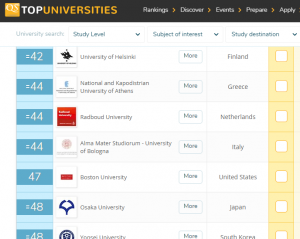The Dentistry Department of National and Kapoodistrian University of Athens is ranked 44th among 500 universities, according to the QS Top Universities rankings.
It is the first time the Dentistry University is included in the top 50 schools globally.
The QS World University Rankings is compiled using six simple metrics that capture university performance:

Academic Reputation (40%)
The highest weighting of any metric is allotted to an institution’s Academic Reputation score. Based on the Academic Survey of QS, it collates the expert opinions of over 80,000 individuals in the higher education space regarding teaching and research quality at the world’s universities. In doing so, it has grown to become the world’s largest survey of academic opinion, and, in terms of size and scope, is an unparalleled means of measuring sentiment in the academic community.
Employer Reputation (10%)
Students will continue to perceive a university education as a means by which they can receive valuable preparation for the employment market. It follows that assessing how successful institutions are at providing that preparation is essential for a ranking whose primary audience is the global student community.
Our Employer Reputation metric is based on over 40,000 responses to our QS Employer Survey, and asks employers to identify those institutions from which they source the most competent, innovative, effective graduates. The QS Employer Survey is also the world’s largest of its kind.
Faculty/Student Ratio (20%)
Teaching quality is typically cited by students as the metric of highest importance to them when comparing institutions using a ranking. It is notoriously difficult to measure, but QS have determined that measuring teacher/student ratios is the most effective proxy metric for teaching quality. It assesses the extent to which institutions are able to provide students with meaningful access to lecturers and tutors, and recognizes that a high number of faculty members per student will reduce the teaching burden on each individual academic.
Faculty/student Ratio constitutes 20 percent of an institution’s final score.
Citations per faculty (20%)
Teaching is one key pillar of an institution’s mission. Another is research output. QS measure institutional research quality using our Citations per Faculty metric. To calculate it, the total number of citations received by all papers produced by an institution across a five-year period by the number of faculty members at that institution.
To account for the fact that different fields have very different publishing cultures – papers concerning the Life Sciences are responsible nearly half of all research citations as of 2015 – we normalize citations. This means that a citation received for a paper in Philosophy is measured differently to one received for a paper on Anatomy and Physiology, ensuring that, in evaluating an institution’s true research impact, both citations are given equal weight.
QS uses a five-year publication window for papers, so for this edition it looked at papers published from 2012 to 2016. It then takes a look at a six-year citation window; reflecting the fact that it takes time for research to be effectively disseminated. In this edition it look for citations from 2012-2017.
All citations data is sourced using Elsevier’s Scopus database, the world’s largest repository of academic journal data. This year, QS assessed 66 million citations from 13 million papers once self-citations were excluded.
International Faculty/ Student Ratio (5%)
A highly international university acquires and confers a number of advantages. It demonstrates an ability to attract faculty and students from across the world, which in turn suggests that it possesses a strong international brand. It implies a highly global outlook: essentially for institutions operating in an internationalised higher education sector. It also provides both students and staff alike with a multinational environment, facilitating exchange of best practices and beliefs. In doing so, it provides students with international sympathies and global awareness: soft skills increasingly valuable to employers. Both of these metrics are worth 5% of the overall total.



































